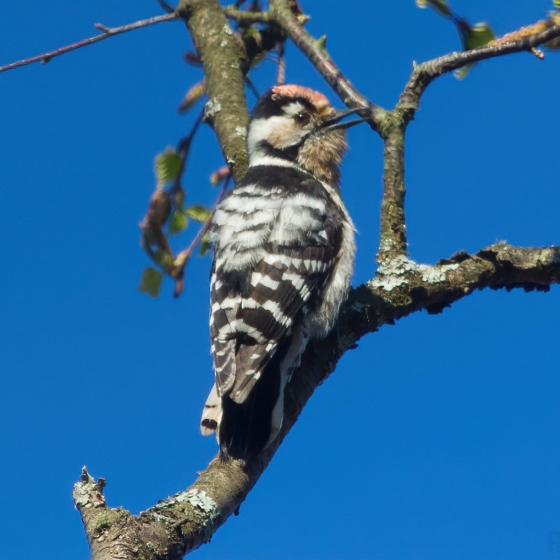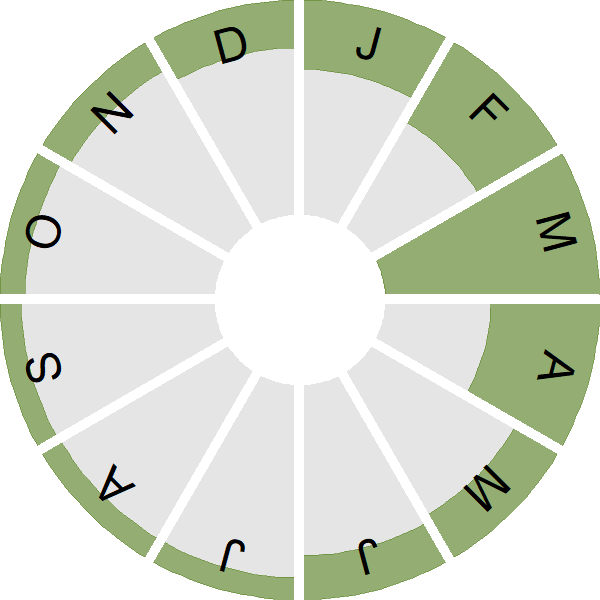Lesser Spotted Woodpecker

Introduction
This sparrow-sized woodpecker, with its black and white plumage and red crown, has been lost from many of its former haunts.
Restricted to England and Wales, we have seen substantial declines since the 1980s, the reasons for which remain unknown. The loss of open woodland habitats may be one factor, but others – including possible competition with an expanding Great Spotted Woodpecker population – also need to be considered.
Lesser Spotted Woodpeckers start their breeding season early in the year, their drumming display one of the few indications of their presence.

Key Stats
Identification
ID Videos
This section features BTO training videos headlining this species, or featuring it as a potential confusion species.
Great & Lesser Spotted Woodpeckers
Songs and Calls
Call:
Other:
Status and Trends
Conservation Status
Population Change
The Lesser Spotted Woodpecker has declined significantly and very rapidly since around 1980, following a shallower increase; it had already contracted in range between the first two atlas periods (Gibbons et al. 1993), and has subsequently disappeared from many more of its former localities (Balmer et al. 2013). The species qualifies easily for red listing.Although the Common Bird Census was able to monitor populations until that scheme ended in 2000, the species is now so rare that it is recorded on only 10-20 Breeding Bird Survey squares annually and hence BBS results are not routinely published. The combined CBC/BBS trend is shown in spite of the low BBS sample size to reflect the substantial long-term decline which has occurred. The species is now so rare that Rare Breeding Birds Panel figures provide an alternative way to monitor the shorter-term trends: all UK breeding records since 2010 should be forwarded to the RBBP, who have established recording criteria. Lesser Spotted Woodpecker has been one of the most strongly declining bird species in Europe, with widespread steep decrease since 1980 (but with a wide confidence interval: PECBMS 2007): the European trend is described currently as 'uncertain', although the trend graph shows a steep decline in the early 1980s (PECBMS: PECBMS 2020a>).
Distribution
The Lesser Spotted Woodpecker's winter and breeding distributions are very similar, though with more squares occupied in winter, perhaps due to dispersal, but also perhaps a greater detectability in February when birds are displaying. London and surrounding counties form the largest remaining area of continuous breeding occupation; more isolated 10-km squares might hold no more than a single pair.
Occupied 10-km squares in UK
or view it on Bird Atlas Mapstore.
or view it on Bird Atlas Mapstore.
European Distribution Map
Distribution Change
Losses of range have been extensive in all regions, but especially in East Anglia and in northern and westernmost England. Overall, the breeding range contracted by 11% up to the 1988–91 Breeding Atlas and subsequently by a further 34%.
Change in occupied 10-km squares in the UK
or view it on Bird Atlas Mapstore.
or view it on Bird Atlas Mapstore.
Seasonality
Lesser Spotted Woodpeckers are recorded throughout the year but most often detected during late winter and early spring during territorial defence.
Weekly pattern of occurrence
The graph shows when the species is present in the UK, with taller bars indicating a higher likelihood of encountering the species in appropriate regions and habitats.

Movement
Britain & Ireland movement
Foreign locations of birds ringed or recovered in Britain & Ireland
Dots show the foreign destinations of birds ringed in Britain & Ireland, and the origins of birds ringed overseas that were subsequently recaptured, resighted or found dead in Britain & Ireland. Dot colours indicate the time of year that the species was present at the location.
- Winter (Nov-Feb)
- Spring (Mar-Apr)
- Summer (May-Jul)
- Autumn (Aug-Oct)

Biology
Productivity and Nesting
Nesting timing
Egg measurements
Clutch Size
Incubation
Survival and Longevity
Survival is shown as the proportion of birds surviving from one year to the next and is derived from bird ringing data. It can also be used to estimate how long birds typically live.
View number ringed each year in the Online Ringing Report.
lifespan
Survival of adults
Biometrics
Wing length and body weights are from live birds (source).
Wing length
Body weight
Ring Size
Classification, names and codes
Classification and Codes
- Order: Piciformes
- Family: Picidae
- Scientific name: Dryobates minor
- Authority: Linnaeus, 1758
- BTO 2-letter code: LS
- BTO 5-letter code: LESWO
- Euring code number: 8870
Alternate species names
- Catalan: picot garser petit
- Czech: strakapoud malý
- Danish: Lille Flagspætte
- Dutch: Kleine Bonte Specht
- Estonian: väike-kirjurähn
- Finnish: pikkutikka
- French: Pic épeichette
- Gaelic: Snagan-daraich-beag
- German: Kleinspecht
- Hungarian: kis fakopáncs
- Icelandic: Stubbspæta
- Italian: Picchio rosso minore
- Latvian: mazais dzenis
- Lithuanian: mažasis margasis genys
- Norwegian: Dvergspett
- Polish: dzieciolek
- Portuguese: pica-pau-galego
- Slovak: datel malý
- Slovenian: mali detel
- Spanish: Pico menor
- Swedish: mindre hackspett
- Welsh: Cnocell Fraith Fach
- English folkname(s): Barred Woodpecker, Hickwall
Research
Causes of Change and Solutions
Causes of change
The demographic causes of decline are not yet known and, although there is low breeding success in some populations, the reasons for the decline are unclear.
Further information on causes of change
The demographic causes of decline are not yet known, and although there is low breeding success in some populations the reasons for the decline in the UK and elsewhere in Europe are unclear (Charman et al. 2009). A study of nest data in Britain found that the mean number of young fledged has declined since the 1980s, possibly exacerbated by the generally warmer springs, with loss of chicks, probably as a result of starvation, being the main cause of low productivity; hence this could potentially have contributed to the population decline (Smith & Smith 2020). However, a detailed field study in Sweden provided good evidence that neither clutch size, brood size in successful nests, fledging success in successful nests nor mean nestling weight differed significantly there between years, despite a threefold difference in population variation (Wiktander et al. 2001).
Loss of open woodland is one factor that has been suggested to have contributed to declines in this species. Lesser Spotted Woodpecker is a species that requires mature, open woodland and large areas of woodland at a landscape scale (Wiktander et al. 2001, Charman et al. 2010). Wiktander et al. postulate that the decrease in the area of deciduous forest in Sweden is probably one cause of this species' decline, although they present no specific evidence to support this (Wiktander et al. 1992). Loss of dead wood within woodlands has been proposed as another factor; however, given that dead wood has increased in Britain (Amar et al. 2010) this seems an unlikely cause here. A field study in Poland provided evidence that Lesser Spotted Woodpecker presence is closely correlated with the amount of dead wood and large deciduous trees (Angelstam et al. 2002). In their review of the causes of declines of woodland birds Fuller et al. (2005) state that reductions in small-diameter dead wood suitable for foraging may be a factor in the decline, although recent surveys provided evidence that there was no difference in dead-wood abundance between occupied and unoccupied woods (Charman et al. 2010). However, dead snags have a high turnover and were found to be suitable for nesting sites by woodpeckers for only a few years after death and, furthermore, dead-wood conditions may now be more favourable for Great Spotted Woodpeckers (Smith 2007).
A third hypothesis relates to competition and predation. A field study in Sweden found that Great Spotted Woodpeckers compete with Lesser Spotteds for insect food in dead wood when spruce seed crops are low (Nilsson et al. 1992), but evidence for this in Britain is limited (Charman et al. 2010). The two species may compete for nest sites, since they overlap considerably in their use of nesting substrates (Glue & Boswell 1994). Amar et al. (2006) found that Lesser Spotted Woodpecker decreased more heavily in woods with relatively high numbers of grey squirrel dreys but there was no other evidence that squirrel density was a significant factor in declines.
Changing climate has been found to have an impact on survival and reproduction in some populations. In Norway, a positive relationship between spring numbers of Lesser Spotted Woodpecker and previous June temperatures has been interpreted as an effect of temperatures on woodpecker survival and reproduction during the breeding season (Steen et al. 2006, Selas et al. 2008). Steen et al. (2006) also found that winter temperatures exhibit a direct positive effect on winter survival. However, given that there has been a general trend for increasing temperatures in the UK (see here), it seems unlikely that changes in climate have been responsible for Lesser Spotted Woodpecker declines. Work in Sweden and Germany suggests that changes in phenology could play a role in breeding success, finding that declines in food availability during the breeding season are likely to be related to seasonal declines in reproductive performance as woodpeckers adjust their timing of breeding to coincide with the seasonal food peak (Wiktander et al. 2001, Rossmanith et al. 2007). However, there is little further evidence for this. In Britain, breeding success has fallen and is lower than in recent studies in Germany and Sweden; chick mortality is especially high, most probably related to food shortages in the breeding period (Charman et al. 2012, Smith & Charman 2012).
Information about conservation actions
The species requires large areas of mature, open deciduous woodland with deadwood at a landscape scale (Wiktander et al. 2001; Charman et al. 2010), but the decline has occurred even in areas where this habitat has apparently been available. Reasons for the substantial decline of this species remain unclear (see Cause of Change section, above) and investigations are ongoing to try to identify measures that may reverse the downward trend (Smith & Charman 2012).
Publications (1)
Birds of Conservation Concern Wales 4: the population status of birds in Wales
Author: Johnstone, I.G., Hughes, J., Balmer, D.E., Brenchley, A., Facey, R.J., Lindley, P.J., Noble, D.G. & Taylor, R.C.
Published: 2022
The latest review of the conservation status of birds in Wales. The report assessed all 220 bird species which regularly occur in Wales. There are now 60 species of bird on the Red List, with 91 on the Amber List and just 69 - less than a third of the total number of species - on the Green List.
06.12.22
Reports Birds of Conservation Concern


